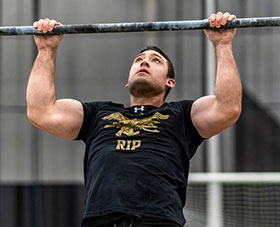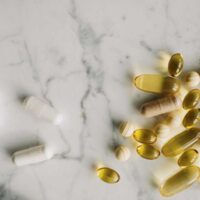In this new series our nutrition expert Korey Van Wyk dives into the science and efficacy of pre-workout ingredients on the market – this month is caffeine.
In the world of supplements, there may not be a more popular or alluring product than pre-workouts. Seemingly every supplement brand has at least one version, and all of them promise to take your workouts to the next level. But what is actually in these products? Do they work as advertised? And are they even safe to take? In this article series, I’m going to break down both common and lesser-known ingredients that you’ll find in pre-workout products. I’ll discuss what each one is, how it is theorized to work, what the research says about its effectiveness, proper dosing, and any side effects or safety concerns. So, grab your favorite energy drink or hydration beverage and let’s discover what’s in your pre-workout!

The Lead Ingredient in Pre-Workouts – Caffeine
You simply cannot talk about pre-workouts without discussing caffeine. Even if you don’t know the ins and outs of this ingredient, you know how it makes you feel! For many of us, we can’t imagine going through our day or tackling our workout without it. There’s a reason coffee is the most popular beverage in the world, and that you will find caffeine in nearly every pre-workout or “energy” product on the market. In the realm of sports nutrition and supplements, it’s one of the most heavily researched compounds available. But with its increasing prevalence in our supplements and food products, it’s more important than ever to know what it is, how it works, and how to use it for both safety and maximum effect.
What is Caffeine?
Caffeine (1,3,7-trimethylxanthine) is a naturally occurring stimulant predominantly found in coffee beans and tea leaves. However, these days you’d be hard-pressed to find any beverage that doesn’t have a caffeinated or “energy” version of it. On top of that, it’s finding its way into food products like bars, gels, gum, and even nasal spray!
How Caffeine Works
As mentioned earlier, caffeine is a stimulant. More specifically, it’s a central nervous system stimulant which means it affects the brain and makes you feel awake, focused, and alert. In the brain, it blocks the action of a neurotransmitter called adenosine. When adenosine meets up with its receptor, it promotes feelings of tiredness and relaxation. This is great (and necessary) for when we’re winding down for the day or trying to fall asleep, but not desirable when we’re running on short sleep, preparing for a morning meeting, or dragging ourselves to a 5 a.m. workout.
Adenosine also decreases the amount of other neurotransmitters in the brain like dopamine, serotonin, and acetylcholine that are beneficial for alertness and performance. When caffeine is present, it blocks adenosine from getting to its receptor. This keeps those feelings of tiredness away and leads to the cognitive effects we all know and love.
This blockade of adenosine is also the reason caffeine improves performance. In addition to bolstering focus and motivation, caffeine reduces the sensation and perception of pain. Because of this, you’re more likely to push a little harder, get a few more reps, train longer, or go a few more miles in your workouts because it feels easier. Caffeine can also directly improve muscle performance by strengthening nervous system signals to the muscle and increasing the amount of calcium in the muscle cell. Both of these effects can result in enhanced muscle force production and improved strength and power.
What Can You Expect from Caffeine?
Caffeine is one of the few compounds in sports nutrition where an identified, logical mechanism actually enhances performance in research and the real world. So, if you take the proper dosage and time it correctly, you can expect to see performance benefits from caffeine. But how much will performance improve? And what types of activities benefit? Here’s an overview of caffeine’s effects on various goals and training outcomes.
Given caffeine’s primary mechanism of action, it would make sense that it has a greater effect on activities of sustained effort as opposed to short bursts. And this does seem to be the case. A 2021 review of caffeine and exercise performance in the Journal of the International Society of Sports Nutrition concluded that activities relying on muscular endurance can improve by 6-7%. Examples of these include things like submaximal squats (60-70% of 1RM) to failure, push-ups to failure, or a plank held for max time. As for maximum strength and power output, improvements are slightly lower but still significant. For activities like a max lift, sprinting, jumping, and throwing, performance increases are in the 2-5% range.
How and What to Take
The most recommended dosage is 3-6 mg/kg of body weight. Individual responses can be highly variable, so where you fall in that range will take some experimentation. Below is a table showing some example ranges:
| Weight (kg) | Dosage Range (mg) |
| 70 | 210-420 |
| 80 | 240-480 |
| 90 | 270-540 |
| 100 | 300-600 |
| 110 | 330-660 |
If you are unaccustomed to caffeine, start with 50-100mg less than 3mg/kg of body weight to test tolerance. If you don’t experience any effects, add 50-100mg at each serving until you notice effects, but aren’t jittery or overstimulated. You can work up to 6mg/kg and don’t notice any significant cognitive effects, then I’m sorry to let you know that you are one of the poor souls who is a low responder from that perspective. I feel for you…I really do because I am one of those poor souls! The highest dosage I’ve seen in research is 9mg/kg and, as you can imagine, the participants started experiencing adverse cardiovascular and gastrointestinal effects at that dose. So, there’s really no need to go above 6mg/kg.
For timing, you’ll want to take your dose 30-60 minutes before your training session or event. Again, you may need to experiment with this to see what the sweet spot is for you. As for the vehicle through which you consume caffeine, this largely comes down to personal preference. Caffeine consumed via coffee can enhance performance just as if you consumed it via an energy drink or pre-workout product. The caveat with coffee is that it’s very hard to know how much you’re taking. The caffeine content from cup to cup can vary massively. So, if you want to know exactly how much you’re taking, a supplemental form is probably best. Just make sure you know how much you’re consuming by checking the serving size and how much caffeine is in each serving.
Potential Side Effects from Caffeine
As alluded to earlier, individual responses to caffeine vary greatly. This is largely due to genetic differences in how fast caffeine is metabolized and cleared from the body. It’s estimated that caffeine can stay active anywhere from 2 to 6 hours. However, its effect can be as short as 90 minutes and as long as 10 hours. So, if you start to experience side effects like an abnormal increase in heart rate, feelings of anxiety, jitters, or disturbed sleep, lower your dosage and alter your timing until you no longer feel those effects.
As many of you know, you do build up a tolerance to caffeine. If you are lucky enough to feel the cognitive benefits, you will need to increase your dosage over time to keep feeling those effects. This is partly due to our bodies adapting by creating more adenosine receptors, requiring a higher dose of caffeine to fill them.
What’s interesting is that even though the cognitive effects of caffeine may wear off, the performance benefits don’t seem to. So just because you don’t “feel” it anymore, doesn’t mean it’s not working. However, once you get to that 6mg/kg dose, there’s no benefit to going any higher even though you’re sad that you no longer see sounds and hear colors.
Final Notes
Now that you’re clued in on how caffeine works, how much to take, and when to take it, you can make the most informed choices for your body and performance. Caffeine isn’t one-size-fits-all. You might be lucky and benefit from the lower end of the dosage scale or be someone who could take a nap after drinking a strong cup of coffee. Either way, it’s crucial to know how you respond and how much you’re consuming in a sitting. Caffeine is one of the few supplements with strong research to support it and can be a great tool in your toolbox. But, like all tools, it needs to be used appropriately and for the right situations!
Looking for a Supplement for Muscle Recovery? Try myHMB!
MyHMB (scientifically known as beta-hydroxy beta-methylbutyrate or HMB) is a metabolite of the amino acid leucine. MyHMB aid in increasing muscle protein by acting on both sides of the metabolic pathways or protein balance. It stimulates muscle protein synthesis while decreasing muscle protein breakdown. This allows you to increase strength and power, blunt muscle damage, and improve recovery after intense training. Learn more >















